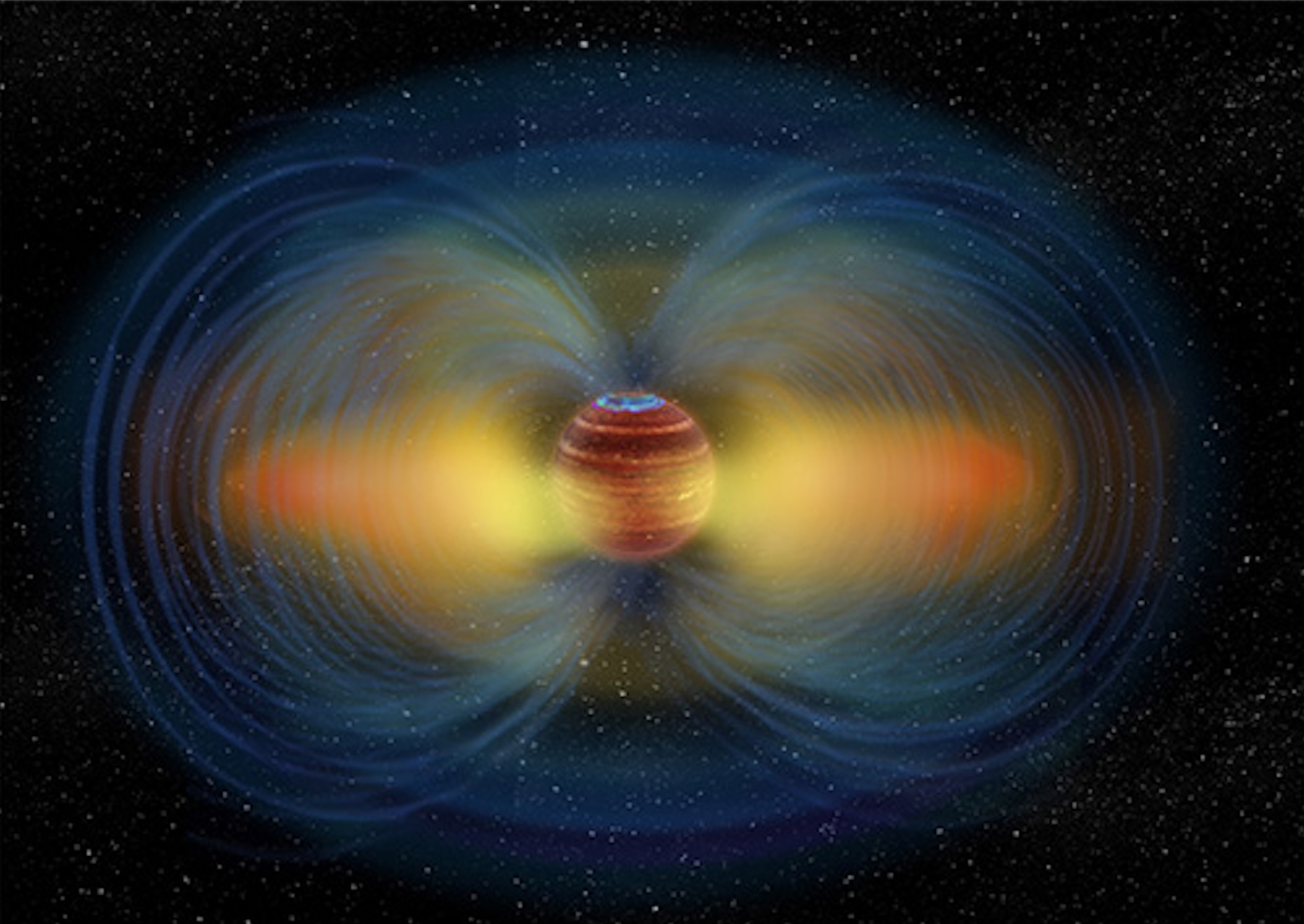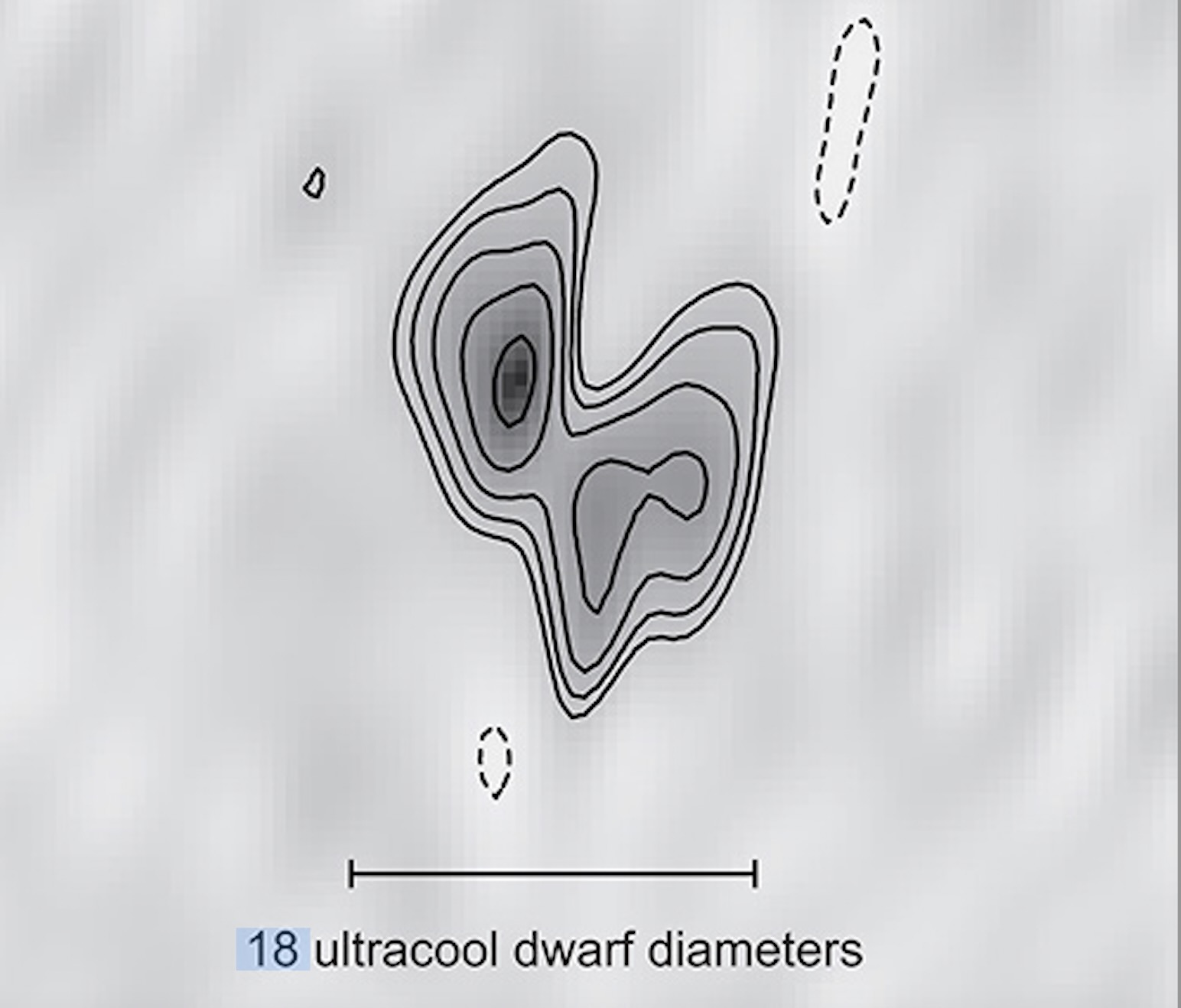Radiation belt seen beyond our solar system for the 1st time
Astronomers have observed a radiation belt around an ultracool dwarf star, the first ever seen outside the solar system.

Astronomers have observed a radiation belt outside the solar system for the first time, imaging high-energy particles trapped by a magnetic field around an ultra-cool dwarf star around 18 light-years from Earth.
The newfound radiation belt is double-lobed, just like the radiation belts that encircle Jupiter, the largest planet in the solar system. But if the dwarf star's radiation belt were placed next to that of Jupiter, it would be 10 million times brighter.
The radiation is in the form of persistent, intense radio emissions. Imaging revealed the presence of a cloud of high-energy electrons trapped in the magnetic field of the dwarf star, which is known as LSR J1835+3259.
"We are actually imaging the magnetosphere of our target by observing the radio-emitting plasma — its radiation belt — in the magnetosphere," research lead author and University of California, Santa Cruz postdoctoral fellow Melodie Kao said in a statement. "That has never been done before for something the size of a gas giant planet outside of our solar system."
Related: Listen to the terrifying rumble of Earth's magnetic field being assaulted by a solar storm

The image was captured by the team using a network of 39 radio telescopes, which combined to form a single virtual telescope called the High Sensitivity Array.
LSR J1835+3259 was the only object beyond the solar system that Kao was confident could be observed with enough detail to resolve its radiation belts. And, because the dwarf star has a mass that lies between low-mass stars and brown dwarfs — objects often referred to as "failed stars" because they lack the mass needed to initiate nuclear fusion at their cores — the new observations could help astronomers find the dividing line between small stars and large planets.
Get the Space.com Newsletter
Breaking space news, the latest updates on rocket launches, skywatching events and more!
"While the formation of stars and planets can be different, the physics inside of them can be very similar in that mushy part of the mass continuum connecting low-mass stars to brown dwarfs and gas giant planets," Kao said.
Observing an extrasolar aurora
Strong magnetic fields form a magnetic bubble around a planet called a magnetosphere, which can trap and accelerate charged particles to speeds approaching that of light. Many planets in the solar system have magnetospheres, as does the sun. Even one solar system moon — the huge Jovian satellite Ganymede — has a magnetosphere.
Magnetospheres come with different strengths and different characteristics, however. For example, the magnetosphere of Mercury, the closest planet to the sun, has only around 1% the strength of Earth's magnetic bubble, which is strong enough to protect our planet's atmosphere and life from highly energetic charged particles from the sun. After the sun, Jupiter has the strongest magnetic field in the solar system.
All the planets in the solar system with magnetic fields also have radiation belts consisting of trapped high-energy charged particles around them. While the radiation belts of Earth, known as the Van Allen Belts, are donut-shaped bands of high-energy particles from solar wind, the majority of the particles trapped by magnetic fields around Jupiter creating double lobe-shaped radiation belts come from its volcanic moon Io.
Regardless of their origin, these trapped particles are deflected by magnetic fields toward the poles of planets, generating auroras. On Earth, these take the form of the northern and southern lights here, or the aurora borealis and the aurora australis, respectively.
Related: Where to see the northern lights: 2023 aurora borealis guide
The image of LSR J1835+3259 taken by Kao and her team also marks the first time for a body beyond the solar system that the location of an object's aurora and that of its radiation belts has been successfully differentiated.
Auroras can be used to measure the strength of magnetospheres, if not their shape, so the findings could help determine the strength of the magnetic fields of other dwarf stars, something which is largely unknown currently. Building the theoretical understanding of the magnetic fields of these intermediate-mass objects could, in turn, shed light on the magnetospheres of exoplanets.
"Now that we've established that this particular kind of steady-state, low-level radio emission traces radiation belts in the large-scale magnetic fields of these objects, when we see that kind of emission from brown dwarfs — and eventually from gas giant exoplanets — we can more confidently say they probably have a big magnetic field, even if our telescope isn't big enough to see the shape of it," Kao said.
Because Earth's magnetosphere has been so crucial in protecting life on our planet and allowing it to evolve, scientists theorize that magnetic fields around exoplanets may be key to understanding the habitability of worlds beyond the solar system.
"This is a critical first step in finding many more such objects and honing our skills to search for smaller and smaller magnetospheres, eventually enabling us to study those of potentially habitable, Earth-size planets," research co-author Evgenya Shkolnik, an astrophysics professor at Arizona State University, said in the same statement.
The team's research was published on Monday (May 15) in the journal Nature.
Join our Space Forums to keep talking space on the latest missions, night sky and more! And if you have a news tip, correction or comment, let us know at: community@space.com.

Robert Lea is a science journalist in the U.K. whose articles have been published in Physics World, New Scientist, Astronomy Magazine, All About Space, Newsweek and ZME Science. He also writes about science communication for Elsevier and the European Journal of Physics. Rob holds a bachelor of science degree in physics and astronomy from the U.K.’s Open University. Follow him on Twitter @sciencef1rst.









